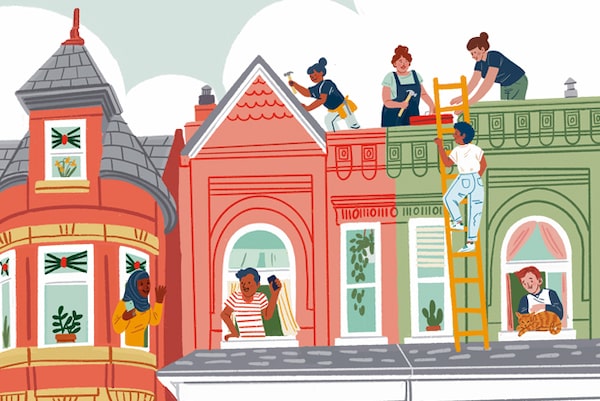Illustrations by Salini Perera

On Nextdoor, members can only see the posts and activities of users in their own neighbourhood and those immediately adjacent.
Marie Moliner needed help. Her 62-year-old husband, former Ontario Superior Court judge Kevin Whitaker, had been diagnosed with Parkinsons and Lewy body dementia. Moliner, a former lawyer, suddenly found herself a full-time caregiver. She needed someone to share the load.
The couple had lived in their Dundas West neighbourhood in Toronto for almost 30 years, yet, many of her neighbours were still strangers. As Moliner began her search for caregiving support, she wondered if there might be someone close by. She’d heard about a new social network called Nextdoor that sorted users into neighbourhood-specific private groups. In early January she signed up and published a post.
The responses flooded in immediately. The art therapist down the street would swing by. So would the reflexologist. A registered nurse who played the violin reached out. In just two weeks, Moliner received seven responses and three in-person visits.
It’s the type of story Nextdoor likes to hold up as an example of what a social network “based on proximity, not preference,” can achieve. The network launched in the United States in 2011 and arrived in Canada in September of last year.
Unlike its behemoth predecessors, such as Facebook, Twitter and Instagram, Nextdoor sorts its users into hyper-local groups according to where they live. Members can only see the posts and activities of users in their own neighbourhood and those immediately adjacent and every user must verify their real name and address via geolocation, phone bill address, a neighbour’s invitation or by requesting a postcard with a code to be sent to the user’s home address.
“Knowing that your neighbourhood is made up of real people elevates the level of trust,” says Christopher Doyle, Nextdoor Canada’s country lead. “Accountability cultivates kindness.”
We blame the internet and social media for a wide swath of the societal ills that currently plague us, from soaring depression rates to election tampering to the global proliferation of misinformation. In the face of such widespread online dysfunction, Nextdoor’s dream of a kinder internet seems almost quaint. Could a hyper-local, verified social network temper the cruelty spewed by a global, anonymous internet?
At the Centre for Humane Technology (CHT), a team of Silicon Valley insiders – advisers include a Facebook co-founder and an early YouTube designer – have made it their job to track the problematic nature of online social interactions.
In its "Ledger of Harms,” the CHT paints a bleak picture of our brains on social media. Algorithms push users toward more of what they like, breeding polarization and extremism. Photo-sharing apps encourage competition and comparison as we battle for engagement and likes. Anonymous users troll and attack without accountability or awareness of the human cost of their behaviour.
Can Nextdoor be any different?

Let’s take a look at my own online life to compare. A quick survey of my personal Facebook feed yields, in no particular order: photos of a celebratory get-together (wasn’t invited), news of a colleague’s successful grant application (should have applied), an actor’s new headshots (they look good – better than me?) and photos of someone’s baby (where’s mine?). I won’t subject you to the battle of trolls that is my Twitter feed or the barrage of other people’s vacation photos and stylized food shots that makes up my Instagram feed.
Compare that to my recent Nextdoor feed, which includes a request for carpet cleaning recommendations, a found tabby cat, a walk in need of shovelling, a house painter offering his services, a coyote sighting and a complaint about an annoying car alarm.
“I think algorithms on other platforms may tend to reward any type of engagement,” Doyle says. “We’re more interested in rewarding offline interactions and kindness.”
It’s those offline interactions that matter, says psychologist Susan Pinker, author of The Village Effect: How Face-To-Face Contact Can Make Us Healthier, Happier and Smarter. One of the strongest indicators of physical and mental health is something she calls social integration – the number of daily social interactions you have with other humans, no matter how brief or superficial.
“I’m talking about the chat with your neighbour before you get in the car, or with your colleagues as you pass them in the hallway,” Pinker says. “Those bonds are extremely protective physiologically.” Replacing these interactions with online exchanges doesn’t work, she says, because we miss out on what she calls “soft signs” – a pat on the hand, eye contact, body posture, micro expressions on the face – that indicate levels of trust in the other person. “We’ve evolved as a social species to see the whites of each other’s eyes,” Pinker says. “When we have a medium that leapfrogs over that step, we get into a lot of trouble.”
That leapfrogging, and the subsequent isolation we feel, is reflected in the data. A 2019 study from the University of Pittsburgh found that for every 10 per cent increase in negative experiences on social media, participants reported a 13 per cent increase in feelings of loneliness. In 2016, one-person households became the most common household type for the first time in Canadian history (28 per cent of us live alone). A 2009 Statistics Canada study found that an estimated 1.4 million Canadian seniors report feeling lonely.

Nextdoor is designed to address those shifts. Rather than encouraging posts about individual experiences or ideas, it prompts members to post a “message, event, poll or urgent alert.” Instead of “liking” posts, users “thank” the post’s creator. (The company reports that Canadians use this button more than anyone else.) An algorithm introduced in 2019 sends a “kindness alert” when it detects language that has been flagged in the past and requires the user to reword their post.
As Nextdoor aims for Fred Rogers levels of civility, a built-in expectation materializes: that we’re all going to behave like Ned and Maude Flanders, those up-in-your-business but ultimately well-meaning folks next door. But not everyone is a Ned, and at times, Nextdoor exhibits a tendency to amplify the local voices we least want to hear.
Much of that amplification comes courtesy of the network’s Crime and Safety section, where locals can report everything from package theft to downed power lines. A 2015 investigation by the East Bay Express in Oakland, Calif., found that some residents were using the site to label black community members as suspects for participating in normal activities such as walking down the street or ringing a doorbell. As examples of racial profiling popped up around the United States, Nextdoor jumped into crisis mode, revising reporting requirements so that neighbours now must use at least two other descriptors, such as what the person was wearing or the type of hairstyle they had, before mentioning race.
Even when it is free of racial bias, the section still has the potential to foster uneasiness. Regular updates of things nearby to fear – whether a coyote, a home invader or a package thief – while ostensibly helpful, can breed paranoia. To wit, before Nextdoor, I left the back door open. Now, I lock it.
And in a society that often tells us the best neighbour is the one who leaves you alone, it’s worth considering the fact that knowing your neighbours means knowing your neighbours.
On Nextdoor, as in any real life neighbourhood, feuds and pettiness abound. You can check out some of the site’s most piddly and dubious complainers on the Twitter account @bestofnextdoor. “All the avocados at Whole Foods are rock hard,” complains one user, while another seeks advice: “Have you or anyone you know unvaccinated yourself or your children?”
We’ve evolved as a social species to see the whites of each other’s eyes. When we have a medium that leapfrogs over that step, we get into a lot of trouble.
— Psychologist Susan Pinker
Douglas Rushkoff is a media theorist and author of Team Human, an examination of the inhumane nature of many of the technologies we have created. He is unconvinced that Nextdoor is the cure to the digitally induced loneliness that ails us. “Another national, centralized network is not the answer,” he says.
“Real physical space is such a great medium through which to engage with people who are local – you don’t need a big, branded platform. Look at what online platforms have done to our national civic discourse. Do we want to do that to our local civil discourse as well?”
But that big, branded, “local” platform is here. The bane and beauty of Nextdoor is that it reflects community and belonging to a community can be a messy, complicated affair. Yet, even when it’s annoying, there’s something about the heartwarming banality of it that really does make you feel like you’re part of a neighbourhood, warts and all.
“I’m not the only person having issues with Canada Post deliveries. I’m not the only one who’s seen the coyote,” says Jess Watt, a user in my apparently coyote-infested neighbourhood. “What I’ve found most rewarding about Nextdoor is knowing that I’m not alone.”
For Moliner and her husband, the impact of Nextdoor is tangible. Just a few days after her posting, 80-year-old neighbour Linda Cook sat in the couple’s living room, discussing Orwell and Homer with Whitaker. She’s visited twice more since then.
“I’m pretty skeptical of platforms as effective community-building mechanisms,” Moliner says. “But to the extent that Nextdoor provides a hub for local insider information, I think it’s very much a community asset. Like anything else, it’s all in how you choose to use it.”
I’m with Moliner. While Facebook and Instagram make me feel as if I’m falling behind in life and Twitter can enrage me, scrolling through Nextdoor just reminds me that it’s time to shovel the walk. It also tells me that I’m surrounded by people who could use a hand – and who would probably lend me one back if I asked.

Background: Neighbourhood social-media site Nextdoor preparing for Canadian expansion
Related: Facebook expands Local Alert tool in bid to help in emergencies



